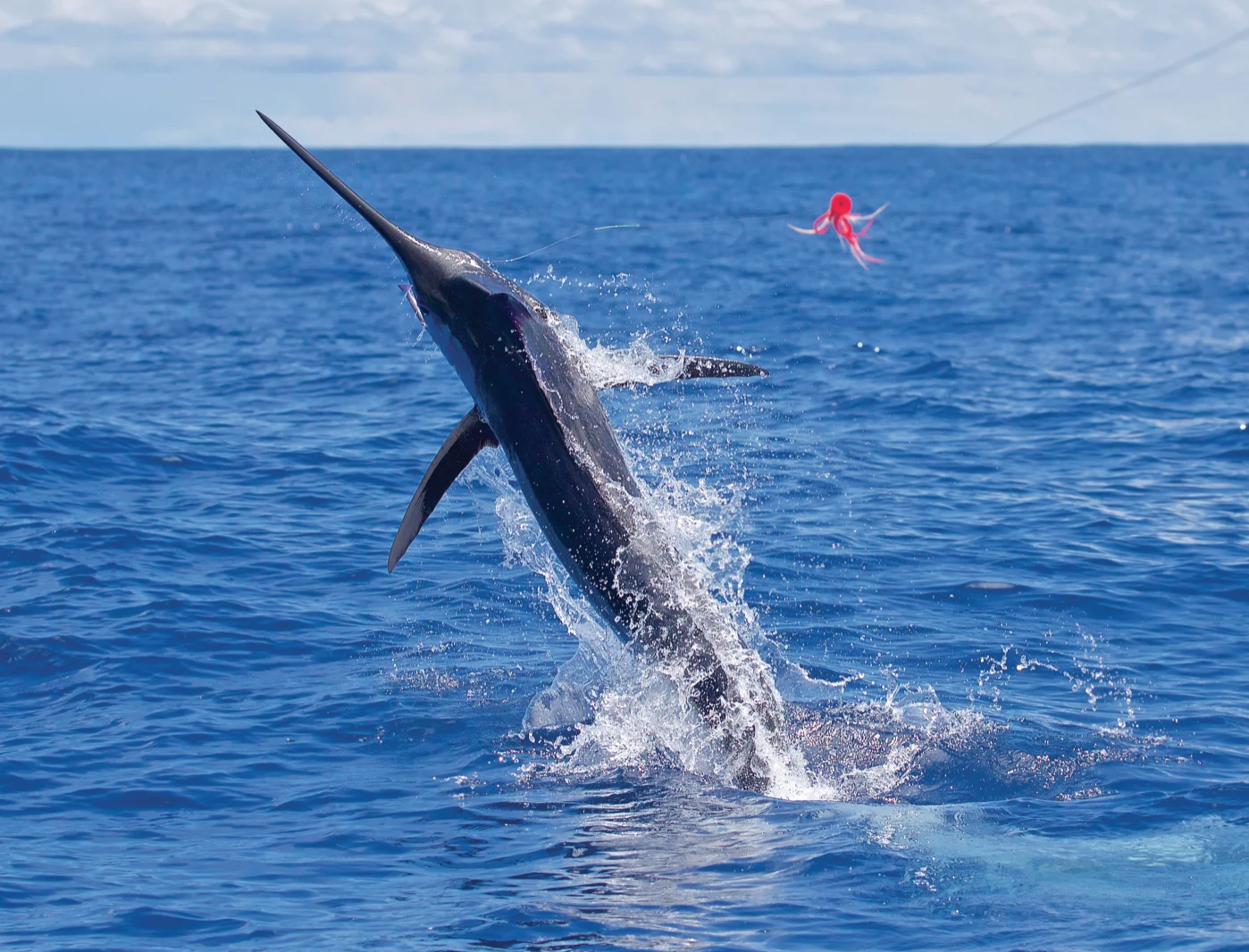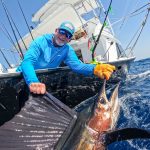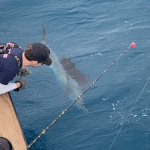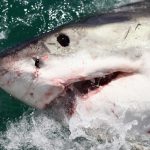Article Courtesy: anglersjournal.com | Updated: 1/31/20 | Click here for original article
Nothing Like It
A longtime light-tackle angler says few things compare with taking a blue marlin on the fly
Photos by Pat Ford
Few things compare to the thrill of hooking a blue marlin on a fly.
I was standing at the stern of Tuna Trappe, a 57-foot Island Boat Works captained by Chris Sheeder. Behind me, a 300-pound blue marlin was tail-walking, completely out of the water, for maybe 20 jumps. This adventure was born more than a year ago when Sheeder posted a photo of his boat’s 26 marlin releases over a three-day trip to Costa Rica’s fish aggregating devices 70 to 130 miles into the Pacific. I’d heard about these FADs perched on seamounts, and when Sheeder had a cancellation last year, Rufus Wakeman and I jumped at the chance to join him.
I also had heard horror stories about melted drags and broken rods, and charter captain Jake Jordan insists that the only fly reel that can tolerate a blue marlin is a Mako 9700, which I do not own. Wakeman, who has been catching marlin on the fly for years, was bringing three Temple Fork billfish rods and Nautilus Monster reels, so all I packed was my Nautilus Monster and my cameras.

Pat Ford and Rufus Wakeman fished Nautilus Monster reels and Cam Sigler flies. With 20-pound tippet and minimal drag (less than 2 pounds) when the fish started greyhounding.
We arrived at Marina Pez Vela, the lodge in Quepos, Costa Rica, in time for a late lunch. Shortly thereafter we were heading for the FADs. The plan was to run offshore at night and start fishing at daylight. We would fish from dawn to dusk for three days. Our destination was a half-dozen seamounts that rise out of 15,000 feet of water to around 4,000 to 1,500 feet from the surface. A FAD consists of a huge concrete block chained to a stainless steel buoy that rests about 90 feet below the surface. A polyurethane rope is attached to the buoy, and attached to the line is all manner of things that float 40 to 50 feet under water and attract baitfish: nets, PVC rectangles, tarps, palm fronds.
As we steamed into the night, Sheeder explained how we would fish. He’d run two hookless trolling lures, a dredge and small tuna or bonito as teasers. In addition, he had a spin rod rigged with a Charlie Tuna III — a fiberglass bonito replica made by KingSailfish Mounts. When the teasers were in and a marlin faded off the fly, Capt. Nico Melendrez — a skipper at Casa Vieja Lodge in Guatemala, who has probably laid hands on more than 50,000 billfish — would cast the Charlie to retease.
Three Phases
The briefing didn’t do much to help me sleep that night. At 5:30 a.m. our lines were in the water. Wakeman was up first, and we planned to switch after each bite. The morning started slowly, so we ran for about half an hour to another FAD. A couple of marlin came to the teasers but showed no interest in the fly.
Eventually, however, the bite came on. This was the drill: When Sheeder spotted a marlin, whoever was up would grab the fly rod, which was always on the starboard side of the cockpit. When everyone was ready, including the fish, Sheeder would shift to neutral and yell, “Cast!”
I was amazed by the speed and violence of the marlin. Everything happens very quickly once the fish determines that the pink and white Cam Sigler fly might be edible. Sailfish whack the fly with their bill, nibble on it, follow it; blue marlin murder it.
Sheeder explained the three phases to catching a blue marlin on fly. The first is the strike. You set the hook with the rod. Do not strip-strike, or you will snap the 20-pound tippet every time. The drag is set at just under 2 pounds, and the fish’s momentum is usually sufficient to set the hook. A few pumps with the rod helps — just don’t touch the reel.
Phase two is when the marlin is hooked and starts greyhounding across the surface. This is a critical time for a 20-pound tippet. Sheeder and Wakeman use a 600-grain Cortland billfish line with the running line cut back to about 10 feet from the sinking section. Wakeman uses about 80 feet of hi-vis 40-pound mono between the fly line and the 30-pound braid backing, but Sheeder goes straight from backing to fly line, to reduce line drag as much as possible. Both approaches work.
Phase three is after the fish sounds, and you have to pump it back to the surface. During this stage you can increase the drag to 4 pounds. Most of the pressure is applied by palming the reel, and you have to be ready for a line-snapping burst of speed at any time. If the marlin surfaces, it usually starts greyhounding, and you have to quickly drop back to minimal drag.
Wakeman has caught every species of billfish on the fly except swordfish, so he was up first. The first marlin smacked the fly, but the hook pulled after a few seconds, so I gave him another shot. We raised a pair of marlin that both honed in on the tuna teaser. They darted back and forth in our wake, their tails and pectoral fins lit up to a brilliant neon blue. They were crazy fast, and one hit the fly going from right to left with such speed that it tangled in the last teaser lure line as it was retrieved. The ensuing mess was the end of that fight.
I was up, and I was a bit intimidated. The drag on my Nautilus was set at less than 2 pounds, and we reviewed the instructions, but I was still nervous. These fish were huge. I had hoped for something in the 125-pound class, but everything we’d seen was 200 to 300 pounds. Wakeman’s bites had come close together, and it was only minutes before my first blue appeared. It charged the teaser, then zipped back and forth across our wake until it found the fly. It made three or four passes before striking, but when it made up its mind, its speed was awesome. I leaned the rod to the left, as the marlin hit going right, but as soon as it felt the hook, it jumped and I never got a good set. A few minutes later I got my second chance.
A “Little” One
Two fish came in on the teasers, and the strike was instantaneous. A 200-pounder crushed it, and this time the hook held. The marlin ran off about 100 yards and commenced greyhounding away for another 200. As instructed, I held the rod and watched as backing peeled off the reel. A blue usually takes more than a quarter-mile of backing on its first run, and this guy took every inch, maybe more. The tippet held, and the marlin finally sounded. It was time for some heavy lifting.
I’ve never felt such power on the end of a fly rod. Sheeder’s boat handling is beyond compare, and I’m convinced that the boat plays a larger role in landing a blue marlin than the angler. I was still at 2 pounds of drag, but I could palm the reel to add pressure. It didn’t take long to figure out that there was no way I was going to lift a 200-plus-pound marlin on a 20-pound tippet if it didn’t want to be lifted. More than an hour passed, with minimal progress. I’d gain line, only to lose it. The fish rose to the surface twice but didn’t jump before heading back down. I’d been on the fly line twice, and even fostered the illusion that I was winning. Sheeder eventually allowed me to move up to 4 pounds of drag.
The marlin rose to the surface but was too tired to jump. I did my best to pull it to the stern as Sheeder backed the boat. The leader came to the rod tip, and I officially had my first blue marlin on IGFA-legal fly tackle. We took some photos, then set it free. We estimated the fight took an hour and a half, and the fish weighed about 200 pounds. This was an amazing moment, even for someone who has thrown flies and fished light tackle for decades. What I didn’t realize was that this was a “little” one.
Wakeman was up again, and the bite was still on. He hooked up within minutes. This marlin was huge — we estimated it might have been in the 300-pound range — and it jumped close to the boat. At one point it was heading straight at us, and Sheeder had to gun the engines to get out of its way. It went down and hung there for a while, as expected, but this one liked the surface. It was up and down, jumping, thrashing water, running off line. A half hour into the fight, it surfaced and made several feeble attempts at jumping, then just lay there.
Wakeman released his biggest marlin ever. (It’s illegal to kill billfish in Costa Rica.) The IGFA world record on 20-pound tippet is 288.75 pounds taken by Tom Evans in Australia in 2002. Estimating the weight of a big marlin in the water is tough, but Wakeman’s fish might have been larger.

The fish ran 200-plus pounds, larger than expected. Ford said they often took more than a quarter-mile of backing on the first run.
My next attempt gave me a solid hookup, but the marlin went down 100 yards in seconds, then came straight up, snapping the tippet on its first jump. The 2 pounds of drag was too much, but there was nothing we could have done to change the result. Wakeman caught a sailfish, which looked like a guppy compared to the blues, then hooked a marlin that managed to tangle in the line during its jumping spree and throw the hook, only to have it snag in its back, which made it jump even more. I got lots of photos, but the fight was over pretty quickly as it easily broke off.
We fished until dark every day, but most bites came during midday. When the bite was on, we raised a marlin about every 20 minutes. But as suddenly as it started, it was over. We’d raise a fish now and then, but they wouldn’t tease to the fly — “tourists” as Wakeman called them.
Hot or Cold
The next morning, we woke to clouds and rain. Teasers were out by 5:45, but with the change in weather, we saw no marlin until around 11 o’clock. I was up when the first marlin appeared on the tuna teaser. This one was big — maybe 300 pounds, like Wakeman’s the previous day — and hot. It teased into a frenzy, crashed the fly and sounded at warp speed. We were expecting it to surface and begin the usual antics, but it never did. Two hours later we still had not seen it.
I put as much pressure on that fish as I ever have on anything, and it didn’t react. I’d gain some line now and then, and I tried different angles when the line was straight down, but most of my progress was from Sheeder’s maneuvering the boat to change the angle of pull. At times I’d reduce the drag to almost nothing to see if that would bring up the marlin. It didn’t. Not long after the two-hour mark, the marlin started moving more and came within 30 feet of the surface several times, but it still didn’t jump. I managed to get on the fly line four times, but whenever we got close, the fish headed back down.
During the third hour, I thought I might be winning. I could gain line by actually pressuring the fish. I’ve caught a lot of tuna, and the trick is to take short pumps and keep their head up. If you allow them to point their head down, you’re going to lose line. The short pumps worked, and eventually I could see the marlin on its side directly below me. Each pump brought it closer until it was next to the boat and the leader was on the reel. Melendrez grabbed the leader and set it free.
I’m 75 years old, and I’ve caught a lot of good fish in my life — I’ve even set a bunch of IGFA records — but nothing will top that blue marlin.
Rain caught us right after we released my fish, and we had to run a bit to get away from a thunderstorm. By the time the rain stopped, so had the bite. I was done, too, physically and mentally. Wakeman caught another sailfish but scratched on marlin.
The sun returned on our last day, but the morning bite was slow. Wakeman caught his second marlin, and I hooked another brute that never jumped. After an hour and a half of what was sure to be another ordeal, the hook pulled. Almost immediately after my fish escaped, we raised another hot one that hit Wakeman’s fly, ran off a bit, spit the fly, teased back up on the Charlie, struck the fly a second time — still not hooked — then ate the fiberglass bonito and hung on to it for five minutes while Melendrez tried to pull it away. When a blue is hot, it’s really hot.
Wakeman hooked the next fish, watched it jump into exhaustion and released another 200-pounder. Then the action stopped for several hours. It was either hot or cold.
In total, we raised 38 marlin, had 17 bites, and wound up with five marlin and three sailfish on the fly. The magic of fishing FADs is that you can throw a fly at a dozen blue marlin a day. Some days the action never stops, and you might have 20 bites.

Ford fought one large marlin for more than three hours before getting it to the boat and released. “Nothing will top that blue marlin,” he says.
The key to catching big blue marlin on a fly is keeping the fish on the surface. Once they sound and put out those pectorals, no amount of rod pressure is going to pull them back to the surface, unless you want to spend half a day fighting them. Most of the marlin we caught were whipped in less than 30 minutes. Keeping them jumping is key. And a lot of that is simply luck.
There’s simply no place on the planet like Costa Rica, where an angler can consistently raise this many blue marlin during a three-day trip. Occasionally you’ll run into a striped marlin or a black, and there are always a few sailfish around. The FAD season runs from late June through September and requires spending several nights on the boat. It’s an expensive adventure, and there might only be accommodations for two or three anglers on board, but it’s three days of action that no one forgets.
There are several good options for fishing the Costa Rica FADs, either on fly or with traditional tackle. You can contact Chris Sheeder on Facebook. Billfish fly veteran Jake Jordan is available at keysjake@aol.com. Capt. Bubba Carter, a billfish pioneer, can be reached at captbubbacarter.com. And Will Drost, who runs Maverick sportfishing charters, is available at info@maverickcostarica.com. Drost, Jordan and Carter fish out of Los Sueños Resort & Marina.
This article originally appeared in the Winter 2020 issue of Anglers Journal magazine.










